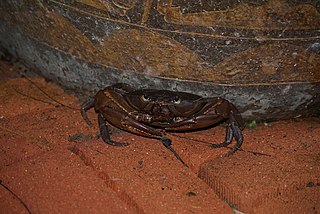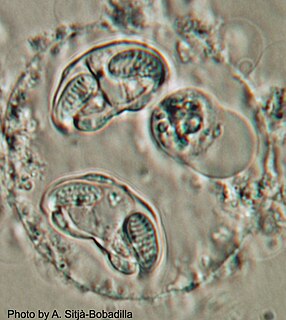| Enteromyxum | |
|---|---|
| Scientific classification | |
| Kingdom: | Animalia |
| Phylum: | Cnidaria |
| Class: | Myxosporea |
| Order: | Bivalvulida |
| Family: | Myxidiidae |
| Genus: | Enteromyxum Palenzuela, Redondo & Alvarez-Pellitero, 2002 |
| Enteromyxum | |
|---|---|
| Scientific classification | |
| Kingdom: | Animalia |
| Phylum: | Cnidaria |
| Class: | Myxosporea |
| Order: | Bivalvulida |
| Family: | Myxidiidae |
| Genus: | Enteromyxum Palenzuela, Redondo & Alvarez-Pellitero, 2002 |
The World Register of Marine Species includes the following species in the genus: [1]

Scrobicularia plana, the peppery furrow shell, is a bivalve mollusc belonging to the family Semelidae.

Onykia is a genus of squids in the family Onychoteuthidae. Due to similarities between the genera, several recent authors consider the genus Moroteuthis a junior synonym of Onykia. The type species is Onykia carriboea, the tropical clubhook squid.
Ceratomyxa is a genus of myxozoan.

Merica is a genus of sea snails, marine gastropod mollusks in the family Cancellariidae, the nutmeg snails.

Blasicrura is a genus of sea snails, marine gastropod mollusks in the family Cypraeidae, the cowries.

Corallimorphus is a genus of colonial anthozoans similar in appearance to sea anemones and in body format to scleractinian stony corals. These animals are cnidarians in the family Corallimorphidae. Members of the genus live off the Pacific coast of the US.
The order Pygocephalomorpha is an extinct group of peracarid crustaceans. It contains five families, and one genus incertae sedis.

Epilobocera is a genus of crabs in the family Epiloboceridae. It is the only genus in its family; this taxonomic arrangement follows the revision of the family Pseudothelphusidae by Álvarez and colleagues.

Rhopalomenia is a genus of solenogasters, shell-less, worm-like, marine mollusks.

Amboherpia is a genus of solenogaster, a kind of shell-less, worm-like mollusk.

Codakia is a genus of saltwater clams, marine bivalve molluscs in the family Lucinidae.

Astarte is a genus of bivalve mollusc in the Astartidae family. It was circumscribed by James Sowerby in 1816. As of 2017, WoRMS recognizes approximately 33 species in this genus.
Myxidiidae is a family of myxozoans.

Acila is a genus of marine bivalves in the family Nuculidae. Acila fossils have been found dating back to 113.0 Ma ago.

Morum is a genus of sea snails, marine gastropod mollusks in the subfamily Moruminae of the family Harpidae.
Hemidonax is a genus of bivalve molluscs. It is the only genus in the family Hemidonacidae, which is the only family in the superfamily Hemidonacoidea in the order Venerida.

Enteromyxum leei is a species of myxozoan, histozoic parasite that infects the intestinal tract and sometimes associated organs, like gall bladder and liver, of several teleostean fish species. Myxozoans are microscopic metazoans, with an obligate parasitic life-style. The parasite stages of this species live in the paracelullar space between fish enterocytes. It is the causative agent of enteromyxosis, or emaciative disease, also known as "razor blade syndrome" in sparid fish. E. leei has a wide host and geographical range within marine fish, and even freshwater fish have been infected experimentally. E. leei initially emerged in the Mediterranean in the late 1980s and it is believed to have been unintentionally introduced into the Red Sea. Its pathogenicity and economic impact depend on the host species. In the gilt-head seabream, it is manifested as a chronic disease that provokes anorexia, delayed growth with weight loss, cachexia, reduced marketability and increased mortality. In other species, it has no clinical signs. In sharpsnout seabream, infection results in very high mortality rates, which have pushed fish farmers to abandon the culture of this fish species.
Enteromyxum scophthalmi is a species of parasitic myxozoan, a pathogen of fish. It is an intestinal parasite of the turbot and can cause outbreaks of disease in farmed fish. It causes a cachectic syndrome characterised by loss of weight, muscle atrophy, weakness and fatigue.
Enterospora is a genus of protists belonging to the family Enterocytozoonidae.

Latrunculia is a genus of demosponges. It is well known for the diverse array of chemical compounds found in its species, including the latrunculins, which are named after this genus. Many of these are medically important, including anti-cancer compounds such as discorhabdins.